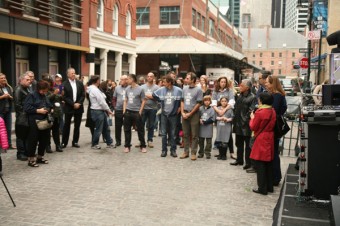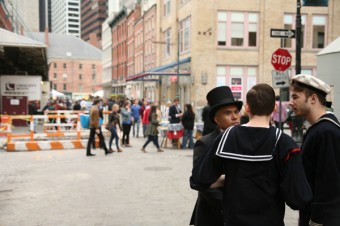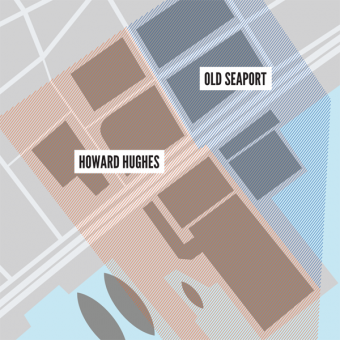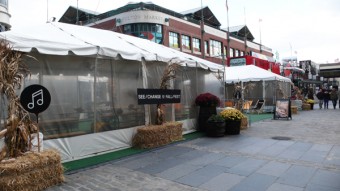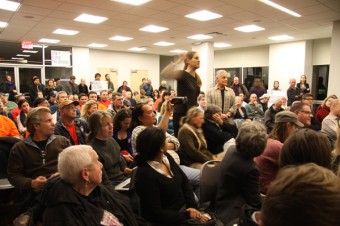Design/Relief
South Street Seaport
Posted By:
Admin
Thursday 5 December 2013
DISCOVERING THE MULTIFACETED SSS
November 2013
Seaport residents and the Old Seaport Alliance unveil new neighborhood branding identity at a block party on October 19th
Photo: Cristian Fleming
South Street Seaport is a neighborhood that keeps its secrets. The true story of the seaport has long been less than clear, even for long-time residents of New York. In fact, asking 10 people what the place is about can get you 10 unique answers. A historically important American landmark, a shopping destination, and Manhattan’s closest connection to the water that surrounds it, South Street Seaport suffered some of the heaviest destruction during Hurricane Sandy last year, inundated with 7-foot flood waters that caused extensive damage, functionally shuttering the neighborhood for the better part of the following year. The receding waterline not only left in its wake a crippled neighborhood, but also exposed some of the deep rooted issues that make the neighborhood so difficult to define. It is in this climate that we enter the story and begin our work.
Living in New York City for 20 years, I admit that while I feel I know my town, the seaport has always confounded me. We’ve spent the past few weeks in the neighborhood and each time there my understanding shifts and I learn how little I ever knew about the richness and depth of the neighborhood – from people spontaneously wearing 19th century clothing, to impromptu busking (which is apparently a common seaport neighborhood pastime), to the budding New Amsterdam Market that has sprung up in recent years on the site of the old Fulton Fish Market. I am quickly learning there is much more to this place than I ever imagined, and so much to explore.
Residents in period costumes for the Old Seaport block party stand
in front of Beekman Street, which divides the neighborhood in two
Photo: Cristian Fleming
Here’s the challenge, though. The seaport is a small, 12 square block area surrounded by the Financial District, with the distinction of hosting some of the city’s oldest architecture, as well as one of its largest shopping malls (Pier 17). Walking the neighborhood, it doesn’t take long to arrive at the realization that the seaport has a split personality, with each half each going so far as to have their own, completely unrelated brands. And it’s not like the difference is subtle. Crossing Beekman Street, which divides the two halves, is almost like walking into a different world. Everything looks different, sounds different, and even smells different.
The neighborhood breaks-up between the residential/local are and
what Howard Hughes Corporation controls, including the upcoming Pier 17 renovation
To understand the current underlying dynamic we need to back up for a minute, to 1983, and the arrival of one of the largest development companies in the US, the Howard Hughes Corporation. Howard Hughes envisioned the seaport as a premiere shopping destination, complete with national retailers, restaurant chains, and entertainment. Since the corporation’s arrival it has set out an aggressive plan to realize this vision. The trouble is that there was already a vibrant local residential and business community. This gave rise to some obvious difficulties, and over the course of 30 years those divisions have deepened, bringing us the South Street Seaport we know today.
Sea/Change is the central branding stage for Howard Hughes,
with mainstream programming activating the plaza around the old Fulton fish market
Photo: Laetitia Wolff
Without a doubt Hurricane Sandy was deeply damaging to the neighborhood by every imaginable metric, but what if the storm also exposed a remarkable opportunity? After all, the seaport’s two separate personalities experienced it together. Could something wonderful come of such an awful experience that tells a new story of the neighborhood – a clear story that rediscovers what the seaport is for all of its stakeholders? How might design be instrumental in realizing that opportunity? What should it do? Why? These are some of the questions we are asking as we begin the South Street Seaport DESIGN/RELIEF project. One thing that we are sure about, though, is that the neighborhoods that suffered most at the hands of the storm have had an endless stream of organizations arriving to do something for them, many unrequested, and often with mixed results for the community. But so few have asked the inhabitants of these neighborhoods what could be done with them. This is our challenge.
Community board 1, November 2013: Residents react to a proposal for a high rise
in the footprint of the Old Fulton Fish Market next to Pier 17
Photo: Cristian Fleming
